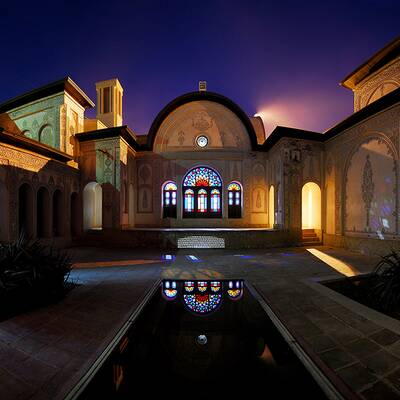Hundred years back no one knew about the ancient structure hidden under a hill, 3 kilometres towards southwest of Kashan, which was later thought to be the remainder of the oldest human civilization. Following a flood in the area, the ruins of ancient Elamite civilization were discovered from underneath and around this mound, Tappe Sialk. The archaeological site of Sialk consists of two hills, 600 metres away from each other, and two cemeteries in the middle of vast fields. The experts speculate that these fields are where the very first community of human, who prior to then, most probably, used to live in caves, opted to reside. Since the discovery there have been two excavation campaigns in the region, once between 1934 and 1937 by a team of French archaeologists headed by Roman Grishman, and the second between 1999 and 2004 by a group of archaeologists led by Dr. Sadegh Malek Shahmirzadi These studies suggest six different periods of occupation for Sialk ancient civilization.
The first period dates back to about 7500 years ago, when the dwellers were simple peasants who lived on the northern hill in small plain huts made of reeds covered with mud. Some objects of this era which were quite primitively made out of stone, a stone axe for instance, or animal bones were found during excavation seasons.
During the second period residents of this northern hill of Sialk made use of mud bricks with irregular shapes to build houses, under which they would bury the dead covered with ochre in a seated position with the knees bent in their torso. Apart from primitive ceramics, there are some metal artefacts and tools among the finds of this period which clearly show the progress in these fields.
In the beginning of the 4th millennium BCE, Sialk residents opted for the hill in the south and resided in houses of rectangular bricks with widows and not so tall roofs. During this third period they still had the dead buried underneath their houses accompanied by some objects of their belonging. The introduction of potter’s wheel, the most significant development of this era, made the craftsmen capable of producing finer ceramics, which were, then, painted and decorated with stunningly beautiful motifs of human and animal figures specific to this age. They were also able to utilize silver to make some artefacts and most probably trade with Khuzestan. It has been said that a massive fire has put an end to this city.
The 4th epoch, between 5000 and 4500 years ago, is believed to be the time when the residents of Sialk managed to read and write in a kind of Elamite scripts. Another massive leap ahead was mastering bronze. However the ziggurat which dates back to this period is undeniably the most significant of all discoveries throughout the excavations. A three storey ziggurat which ascends from southward of the southern hill, thought to be made of 1,25 million bricks and, certainly, the oldest in Iran.
This city seems to have been deserted for the rest of Bronze Age. The 5th period started about 3200 years ago, while a new group chose the southern hill to reside on. Not aware of the remainder of the ziggurat underneath the hill, they flattened the top of it and built a castle-like residence. The southern hill was surrounded with a wall in this era. They had mastered to melt iron and among the objects discovered, there is a grayish sort of pottery which is common to this period. The dead were buried in cemetery A, about 200 metres to the south of the southern hill.
The 6th period starts at about 2900 years ago when the former city was destroyed, on which the conquerors built a new one, although apart from the site they selected to build the city there is no continuity or even similarity between their lifestyle and their predecessors’. The invaders, probably Aryan immigrants, used cemetery B, 250 metres to the west of the southern hill, to bury their dead. The long sprout pottery, which Sialk civilization is quite famous for, belongs to this era.
Aside from Louvre, British Museum and Metropolitan Museum, there is a small museum in Fin Garden, quite close to Tappe Sialk, in which some of the artefacts and tools of this civilization are on display. However not much is left to visit in and around the ruins of Sialk, there is a strange sense of old, breathable in the air and visible in the scenery, one which challenges our responsibility towards preserving the past for the following generations.




